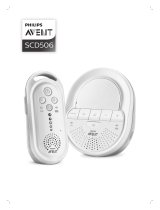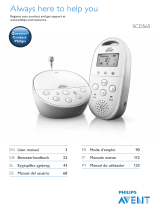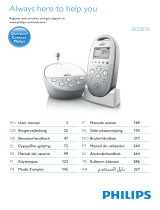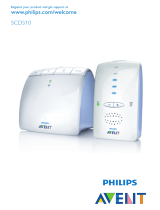
Adapter no. SSA-5W-09 US 075050F
The socket-outlet shall be installed near the equipment and shall be easily accessible.
For the baby unit, only use 1.5V AA alkaline batteries (batteries not supplied).
For the parent unit, only use the SCD530 Li-Ion rechargeable battery pack as supplied with the
appliance.
Dispose of used batteries according to the instructions.
Compliance information
The FCC ID number is located on the casing bottom of the parent unit and in the battery
compartment of the baby unit.
The term ‘IC’ before the certication number signies that Industry Canada technical specications
were met.This certication means that the equipment meets certain radio communications and
operational requirements. This device complies with Part 15 of the FCC Rules and ICES-003 of
Industry Canada. Operation is subject to the following two conditions: (1) this device may not cause
harmful interference, and (2) this device must accept any interference received, including
interference that may cause undesired operation.This device complies also with RSS-213 of Industry
Canada.
Radio interference
This equipment has been tested and found to comply with the limits for a Class B digital device,
pursuant to Part 15 of the FCC Rules and applicable Industry Canada specications. These limits are
designed to provide reasonable protection against harmful interference in a residential installation.
This equipment generates, uses and can radiate radio frequency energy and, if not installed and used
in accordance with the instructions, may cause harmful interference to radio communications.
However, there is no guarantee that interference will not occur in a particular installation. If this
equipment does cause harmful interference to radio or television reception, which can be
determined by turning the equipment off and on, the user is encouraged to try to correct the
interference by one or more of the following measures:
Reorient or relocate the receiving antenna.
Increase the separation between the equipment and receiver.
Connect the equipment to an outlet on a circuit different from that to which the receiver is
connected.
RF Radiation Exposure Statement
This equipment complies with FCC RF radiation exposure limits set forth for an uncontrolled
environment. This equipment should be installed and operated with a minimum distance of 20
centimeters between the radiator and your body. For handheld operation, this equipment has been
tested and meets the FCC RF exposure guidelines. For body-worn operation, this product has been
tested and meets the FCC RF exposure guideline when used with the belt clip or neck strap
supplied with this product. This transmitter must not be co-located or operating in conjunction with
any other antenna or transmitter. This equipment also complies with Industry Canada RSS-102 with
respect to Canada’s Health Code 6 for Exposure of Humans to RF Fields.
Do not attempt to repair or modify this equipment
Any repairs or alterations made by the user to the equipment may void the warranty and
compliance of the equipment. Refer servicing to authorized or designated service centers.
Introduction
Congratulations on your purchase and welcome to Philips AVENT! To fully benet from the support
that Philips AVENT offers, register your product at www.philips.com/welcome.
Philips AVENT is dedicated to producing caring, reliable products that give parents the reassurance
they need. This Philips AVENT baby monitor provides round-the-clock support by ensuring you can
always hear your baby clearly without any distracting noise. The DECT technology guarantees zero
interference from other wireless appliances and a crystal clear signal between the baby unit and the
-
-
-
-
ENGLISH8






















